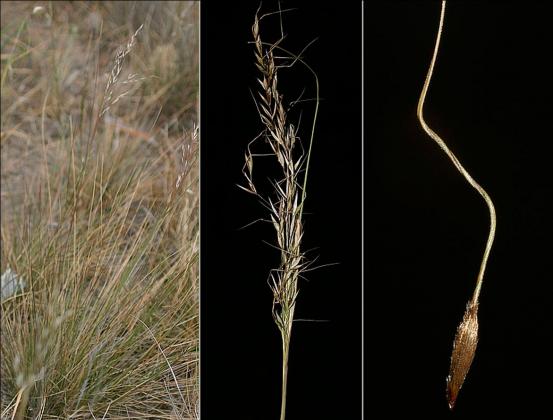
Kneed Spear-grass
Austrostipa bigeniculata
Tufted grass with flower stems to 1.2 m tall. Stem joints (nodes) have dense soft hairs. Leaves inrolled up to 30 cm long and mostly smooth and hairless. Short hairy leaf-collar (ligule) with hairy tufts. Open loose seedheads to 40 cm long. Seeds are purplish, deep reddish brown on maturity, and covered evenly with golden hairs. Hairy bristle or awn 30-60 mm long, bent twice.
| Details | |
|---|---|
| Flora Type | Grasses |
| Former Scientific Name | Stipa bigeniculata |
| Distinctive Features | The stems disintegrate after the seedheads develop. By early winter some stems start to split and fray until the stem tops are wispy tangles of fibre blowing in the wind. Seeds are covered in short whitish hairs, and a hairy bristle or awn that is up to 40 mm long, kinked twice. |
| Biology | Perennial. Preferential grazing of other grasses can lead to flowering and seeding of Spear-grass and their long awns (bristles) can work their way into the skin, mouths and eyes of stock, and contaminate wool. |
| Native Status | Native |
| Flowering Time | Sep-Feb |
| Taxonomy | |
|---|---|
| Phylum | Tracheophyta (Vascular Plants) |
| Class | Magnoliopsida (Flowering Plants) |
| Order | Poales |
| Family | Poaceae |
| Genus | Austrostipa |
| Species | bigeniculata |
Awns (bristles on seeds) are important identification features for Spear-grass species. The caterpillars of Grass Anthelid moths Pterolocera spp. feed on the leaves in winter and spring. A food source for seed-eating birds including finches. Also attracts moths and butterflies.
| Interesting Facts | |
|---|---|
| Similar Species | Kneed Spear-grass can look very like the introduced Chilean Needle Grass Nassella neesiana and Cane Needle Grass Nassella hyalina at certain times of the year, so care must be taken not to eradicate this native grass when trying to control the noxious Needle Grass weeds. |
| Native Status | Native |